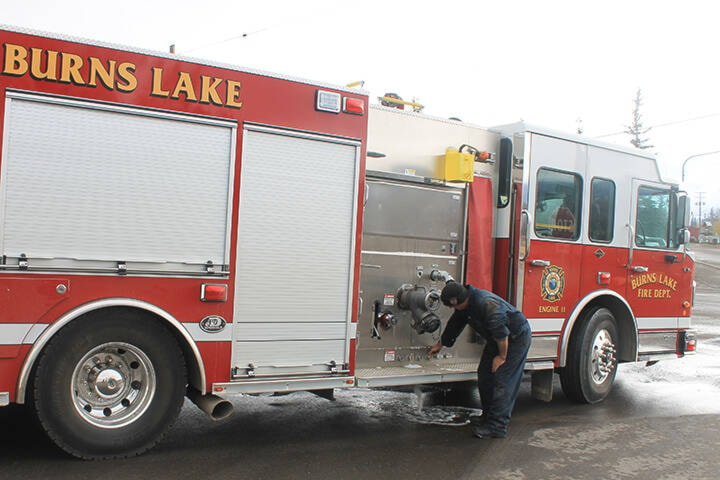It’s time to count the cost of emergency services.
The Village of Burns Lake is applying a sharper pencil to future costs of all kinds, but the first and most important is the life-saving equipment needed by fire and rescue crews. As this fiscal year draws to close, fire chief and the town’s director of protective services, Rob Krause, is mapping out what assets the public has, when it will need replacement, and what maintenance can be expected in between.
“I have worked with the finance department to update our vehicle replacement plan to better reflect the amount we need to be budgeting each year,” said Krause. He provided the Lakes District News with a chart of the vehicles the fire department has (the most expensive items on the list), their respective ages, and the estimated costs of replacement in today’s dollars, with a caution that costs go up over time.
What doesn’t change is the law. Certain firefighting apparatus must be replaced by certain age deadlines, or insurance is null and void.
“The fre department fleet consists of six vehicles in total,” Krause explained. “Three of the vehicles are considered ‘statutory’ which requires the local government to replace them on a designated schedule. This schedule is mandated by the Insurance Underwriters Association, and we are required to follow their guidelines in order to maintain our fire insurance discount for the municipality and the community.”
The three vehicles which are statutory are: Engine 11 (primary), Tender 11 and Rescue 11 (secondary). “The engine, as our primary response vehicle, must be replaced every 20 years, and the other two must be replaced every 30 years.”
There are three other vehicles in the emergency services fleet that do not have such stringent rules attached.
“Engine 12 is our Wildland truck and is owned by ISC and leased to the municipality for $1 per year,” Krause said. “Squad 11 and Command 11 are the two department pickups. Squad will be used by the new bylaw officer position, as well as responding to medical calls and transporting crew to training. Command is used by the on-call officer and for the day-to-day activities of the chief. Both pickups are equipped with initial response capabilities, such as fire extinguishers, medical equipment gas detection and assorted tools for fires and rescues.”
Vehicles aren’t the only asset under the emergency services umbrella. Fire hydrants, for example, are another big-ticket item, considering the importance of their good working order to any given neighbourhood. A couple of them are currently not at a dependable standard to defend the adjacent homes.
“In terms of the fire hydrants, we currently have two hydrants which are out of service and scheduled to be repaired in the spring of 2023,” said Krause. “This will complete the outstanding work from the assessment done in 2021. Moving forward we are budgeting money for annual inspection, and repairs, to deal with problems as they come up.”
It is not uncommon for a municipality in Canada to apply money to problems or replacements as they come up. That ensures the taxpayers’ money is never tied up extraneously, but it also risks sticker shock or borrowing costs to cover a sudden issue.
Think of it like owning a home, and one day the homeowner will need to replace the roof. All the homeowner’s money goes to other life costs up until that point, but then must be addressed in a big lump.
Some municipalities calculate the depreciation into their annual budgets. This means taking from the taxpayer when it isn’t directly necessary, but smooths the big bills when they do come due. Looking again to the hypothetical homeowner, if a little money is set aside on an annual schedule that reflects the expected cost and expected lifespan of the roof, it becomes barely noticeable when the repair has to be made.
Turn that scenario back to the firetrucks, and we see that when it was purchased in 2014, the taxpayer paid $580,000. That same truck today would cost $800,000, and it will absolutely have to be replaced 10-11 years from now and will very likely cost more than $1-million by then. The taxpayer could dig deep for that entire amount in 2033-34 or could set aside a little over $100,000 per year towards that expected bill which would then be paid without much affect to the municipal budget of the day.
There are pros and cons to either way of accounting, but informed-decision making requires careful calculations first.
“Moving forward for amortization of equipment, the village is in the process of completing our asset management plan which will address the capitol replacement of all village assets. This plan includes a capital vehicle plan for the fire department,” said Krause.
